
Browse an alphabetical list of photographs. These historical images portray people, places, and events before, during, and after World War II and the Holocaust.
<< Previous | Displaying results 801-825 of 2641 for "Photo" | Next >>
General Dwight D. Eisenhower (third from left) views the charred remains of inmates of the Ohrdruf camp. Ohrdruf, Germany, April 12, 1945.
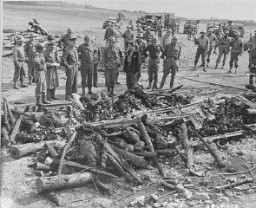
General Dwight D. Eisenhower (center, right) views the corpses of victims of the Ohrdruf camp. Germany, April 12, 1945.
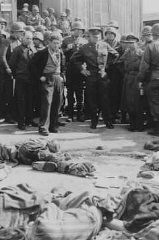
Best friends Ejanga Egiomue (left) and Magdalene Garber (right) on an outing in Berlin, Germany during World War II (likely 1941-1942). Magdalene stayed in Germany, but Ejanga fled to Denmark in 1944. Both women survived the war and stayed in contact with each other, exchanging letters and correspondence well into the 1990s. Magdalene (“Leni”) Garber was born in January, 1919 in Germany. Her parents were Joseph Garber, a Togolese man, and Johanna Maychrzak, a white German woman. Magdalene grew up in…
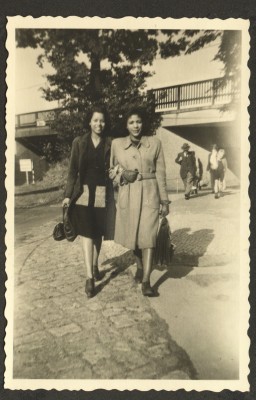
An elderly Jewish woman wears the compulsory yellow badge in the Riga ghetto. Latvia, between 1941 and 1944.
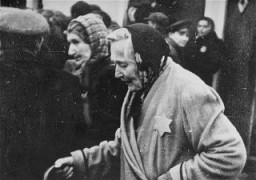
Election officers count votes late into the night after the second round of the 2006 presidential and provincial elections in Bunia, Ituri, Democratic Republic of the Congo.

Poster: "Greater Germany: Yes on 10 April" (1938). This election poster emphasizes the message of jumping on the Nazi political bandwagon, as represented by the hands raised in a unified Nazi salute. Nazi propaganda frequently stressed the power of a mass movement to propel the country forward, subtly underscored by the upward angle of the hands. This poster typifies the propaganda strategy of using simple confident slogans, with bold graphics often using the characteristic Nazi colors of red, black, and…
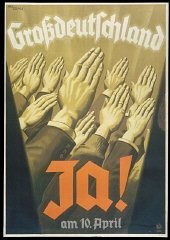
Eliahu Dobkin of the Jewish Agency (left) and Henrietta Szold, founder of the Hadassah Women's Zionist Organization (second from left), await the arrival of the "Tehran Children." Atlit, Palestine, February 18, 1943.
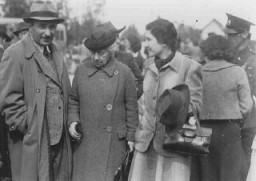
Elie Wiesel became Founding Chairman of the United States Holocaust Memorial Council in 1980. Here, he speaks at a ceremony held during the Tribute to Holocaust Survivors, one of the Museum's tenth anniversary events. Flags of US Army liberating divisions form the backdrop to the ceremony. Washington, DC, November 2003.
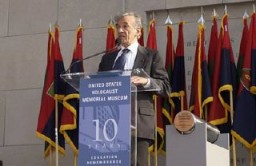
Elie Wiesel with his wife Marion and President Ion Iliescu in Sighet following the presentation of the Final Report of the International Commission on the Holocaust in Romania. Learn more about Romania facing its past.
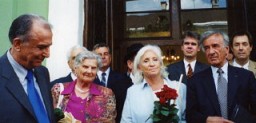
Elie Wiesel speaks at the Faith in Humankind conference, held before the opening of the United States Holocaust Memorial Museum, on September 18–19, 1984, in Washington, DC.
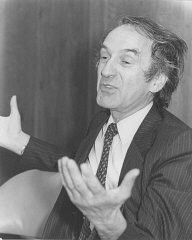
Elie Wiesel speaks at the Days of Remembrance ceremony, Washington, DC, 2001.
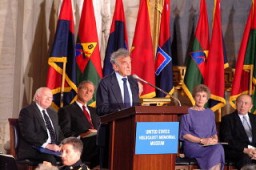
Elie Wiesel speaks at the Days of Remembrance ceremony, Washington, DC, 2002.
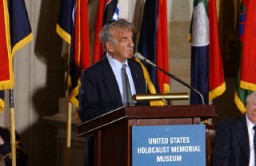
Elie Wiesel speaks at the Faith in Humankind conference, held several years before the opening of the United States Holocaust Memorial Museum. September 18–19, 1984, in Washington, DC.
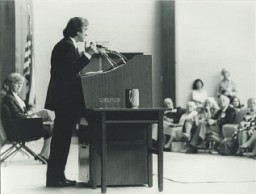
Elie Wiesel (right) with his wife and son during the Faith in Humankind conference, held several years before the opening of the United States Holocaust Memorial Museum. September 18–19, 1984, in Washington, DC.
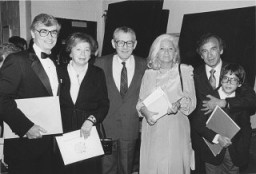
Elie Wiesel with President Ion Iliescu in Sighet following the presentation of the Final Report of the International Commission on the Holocaust in Romania.
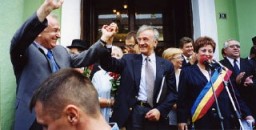
Elisabeth, Hans Werner, and Paul Gerhard Kusserow. Because they were the children of Jehovah's Witnesses, all three were forcibly removed from school on March 7, 1939, and kept separated from their family, which was accused of spiritual and moral neglect, until their liberation in April 1945. This photograph was taken at the Kusserow home in Bad Lippspringe, 1936-1939.
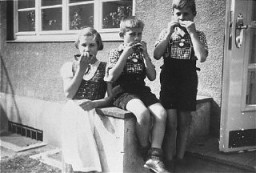
Elsa Eisner, marked with a Jewish badge, walks down a street in Prague. She, her mother, twin sister and other members of the family were deported to Auschwitz in July 1942. Prague, Czechoslovakia, ca. 1941.
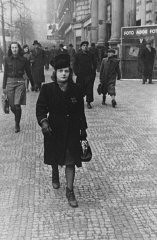
Four emaciated survivors sit outside in the newly liberated Ebensee concentration camp. Photograph taken by Signal Corps photographer J Malan Heslop. Ebensee, Austria, May 8, 1945.
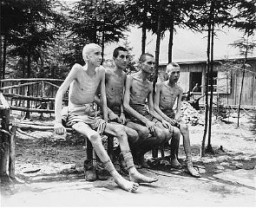
The American Jewish Congress holds an emergency session following the Nazi rise to power and subsequent anti-Jewish measures. United States, May 1933.
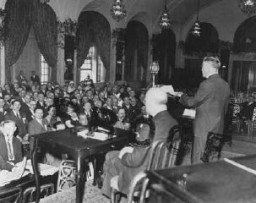
Emmi G., a 16-year-old housemaid diagnosed as schizophrenic. She was sterilized and sent to the Meseritz-Obrawalde euthanasia center where she was killed with an overdose of tranquilizers on December 7, 1942. Place and date uncertain.
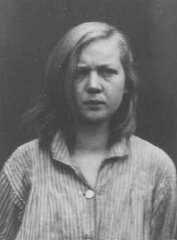
Entrance to the public baths in Wannsee with a sign stating, "Entrance to Jews is forbidden." Berlin, Germany, 1935.
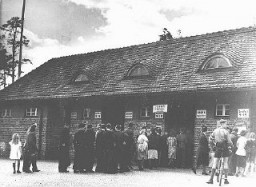
View of the entrance to Oskar Schindler's enamel works in Zablocie, a suburb of Krakow. Poland, 1939-1944.
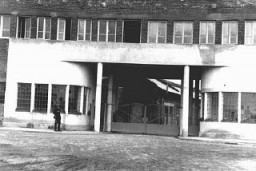
Entrance to the Breendonk internment camp. Breendonk, Belgium, 1940-1944.
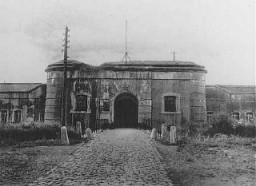
The entrance to the gas chamber in Auschwitz I, where Zyklon B was tested on Soviet prisoners of war. The building in the background is a hospital for SS members. Auschwitz, Poland, date uncertain.
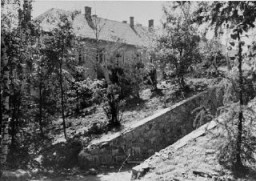
View of the entrance to the Plaszow camp. Plaszow, Poland, 1943-1944.
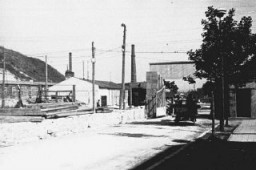
We would like to thank Crown Family Philanthropies, Abe and Ida Cooper Foundation, the Claims Conference, EVZ, and BMF for supporting the ongoing work to create content and resources for the Holocaust Encyclopedia. View the list of donor acknowledgement.